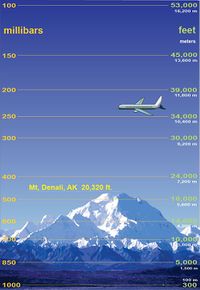Atmospheric pressure
It is the force exerted on a surface by the air above it as gravity pulls it to earth. Atmospheric pressure is commonly measured with a barometer. In a barometer, a column of mercury in a glass tube rises or falls as the weight of the atmospheric changes. Meteorologists describe the atmospheric pressure by how high the mercury rises.
Atmosphere (atm) is a unit of measurement equal to the average air pressure at sea level at a temperature of 15 degrees Celsius (59 degrees Fahrenheit). One atmosphere is 1.013 milibars, or 760 millimeters (29.92 inches) of mercury.
Atmospheric pressure is also called the barometric pressure and varies with elevation above sea level. Also, at a given place it varies slightly from time to time because of changes in meteorological conditions.
In siphonic system, local atmospheric pressure (which depends on elevation above sea level and meteorological conditions) is used to determine the allowable negative pressure. Standard atmospheric pressure at sea level and 15°C is equivalent to a value of H_"o" of about 10.3 m water head.
The negative pressure below which cavitation can occur in the pipework of a siphonic system depends on the velocity of the flow, the degree of turbulence in the flow, the value of atmospheric pressure, and the vapour pressure at the relevant temperature of the rainwater.
Where the pipe material is known to be susceptible to damage by cavitation, the minimum design value of pressure head in the pipework should not be lower than (2.5- H_"o" )m; otherwise the minimum pressure should be not lower than (1.5- H_"o" )m, provided in all cases that the corresponding flow velocity at the point of minimum pressure is not greater than 6 m/s. If the velocity 6 m/s, a less negative value of minimum pressure head is necessary in order to prevent possible cavitation problems.
References
- http://www.nationalgeographic.org/encyclopedia/atmospheric-pressure/
- Fluid Mechanics with Engineering Applications by Robert L. Daugherty, Joseph B. Franzini, E. John Finnemore (p.29)
- http://www.srh.noaa.gov/jetstream/atmos/pressure.html
- http://www.as.wvu.edu/~rbrundage/chapter13a/sld011.html

